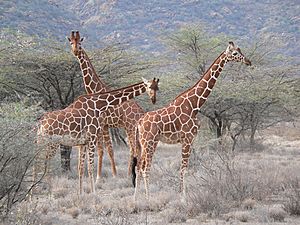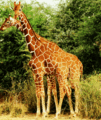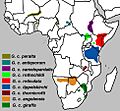Reticulated giraffe facts for kids
Quick facts for kids Reticulated giraffe |
|
|---|---|
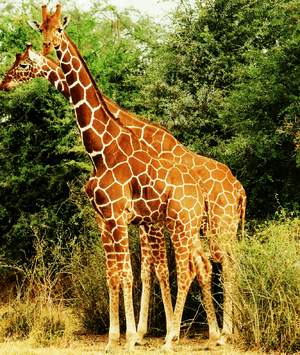 |
|
| Conservation status | |
| Scientific classification |
|
| Kingdom: | Animalia |
| Phylum: | Chordata |
| Class: | Mammalia |
| Order: | Artiodactyla |
| Family: | Giraffidae |
| Genus: | Giraffa |
| Species: | |
| Subspecies: |
G. c. reticulata
|
| Trinomial name | |
| Giraffa camelopardalis reticulata (De Winton, 1899)
|
|
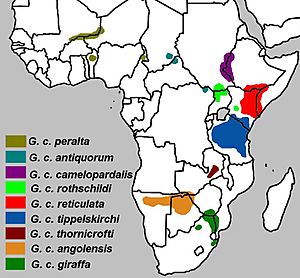 |
|
| Range map in red | |
| Synonyms | |
|
Giraffa reticulata |
|
The reticulated giraffe (Giraffa camelopardalis reticulata), also called the Somali giraffe, is a type of giraffe. It lives in the Horn of Africa, which includes Somalia, southern Ethiopia, and northern Kenya. About 8,500 of these giraffes live in the wild today.
Reticulated giraffes are known for their unique coat. It has large, blocky, liver-colored spots. These spots are outlined by a network of bright-white lines. Sometimes, the spots can look deep red and may even cover their legs. Giraffes are the tallest mammals on Earth!
These giraffes can have babies with other types of giraffes. This can happen if they are in zoos or if different groups meet in the wild.
Contents
What is a Reticulated Giraffe?
The reticulated giraffe is one of several types, or subspecies, of giraffe. The International Union for Conservation of Nature (IUCN) currently says there is one main species of giraffe. This species has nine different subspecies, and the reticulated giraffe is one of them.
A British animal expert named William Edward de Winton first officially named this giraffe in 1899. He called it Giraffa reticulata.
Where Reticulated Giraffes Live
Reticulated giraffes used to live all over Northeast Africa. They like to live in places with lots of open space and trees. These areas are called savannas and woodlands. They also live in areas that flood sometimes, called seasonal floodplains. Sometimes, they can even be found in rainforests.
Helping Reticulated Giraffes
There are only about 9,000 reticulated giraffes left. Because of this, many groups are working to protect them. One such group is called "Twiga Walinzi," which means "Giraffe Guards." This group is part of San Diego Zoo Global.
The "Giraffe Guards" do many important things:
- They hire and train local people in Kenya. These people help watch over the giraffes.
- They use 120 special cameras in Northern Kenya. These cameras take pictures of wild giraffes and other animals.
- They create a photo ID system. This helps them keep track of individual giraffes.
- They tell park rangers about illegal hunting, called poaching. They also remove traps that can hurt giraffes.
- They care for baby giraffes that have lost their parents.
- They teach local communities about why it's important to protect giraffes.
Reticulated Giraffes in Zoos
The reticulated giraffe is one of the most common types of giraffes found in zoos. The Rothschild's giraffe is also very common. The Cheyenne Mountain Zoo in Colorado, USA, has the largest group of reticulated giraffes in North America.
In the past, zoos sometimes bred reticulated giraffes with Rothschild's giraffes. This was because people thought these different types of giraffes bred together in the wild. However, new studies from 2016 showed that these groups do not usually breed with each other in nature.
Some zoos now keep only one type of giraffe. For example, the San Diego Zoo Safari Park and Bronx Zoo have only Rothschild's giraffes. Zoos like Cheyenne Mountain Zoo, Busch Gardens Tampa, and The Maryland Zoo have only reticulated giraffes. Still, some zoos continue to breed both types together.
Images for kids
See also
 In Spanish: Jirafa reticulada para niños
In Spanish: Jirafa reticulada para niños



